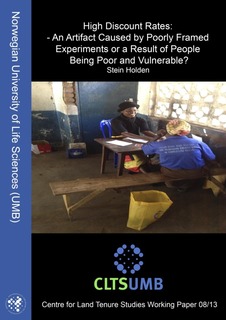| dc.contributor.author | Holden, Stein Terje | |
| dc.date.accessioned | 2018-01-22T13:33:34Z | |
| dc.date.available | 2018-01-22T13:33:34Z | |
| dc.date.issued | 2013 | |
| dc.identifier.uri | http://hdl.handle.net/11250/2478767 | |
| dc.description.abstract | This study revisits the issue whether poverty and shocks are associated with high discount rates by using an incentive compatible Multiple Price List approach in a poor rural population in Africa where a substantial share of the population had been affected by drought in the recent rainy season. Randomized treatments included tests for present bias, magnitude effects and time horizon effects. While the study revealed significant present bias, magnitude and time horizon effects, exposure to drought increased the average rates of time preference by 24-26% and present bias increased discount rates by 9-12% compared to one week delay. | nb_NO |
| dc.description.sponsorship | CIMMYT | nb_NO |
| dc.language.iso | eng | nb_NO |
| dc.publisher | Norwegian University of Life Sciences, Ås | nb_NO |
| dc.relation.ispartofseries | CLTS Working paper;2013:8 | |
| dc.rights | Attribution-NonCommercial-NoDerivatives 4.0 Internasjonal | * |
| dc.rights.uri | http://creativecommons.org/licenses/by-nc-nd/4.0/deed.no | * |
| dc.title | High discount rates : an artifact caused by poorly framed experiments or a result of people being poor and vulnerable? | nb_NO |
| dc.type | Working paper | nb_NO |
| dc.subject.keyword | Poverty | |
| dc.subject.keyword | Climate change | |
| dc.subject.keyword | Risk analysis | |
| dc.subject.keyword | Field experimentation | |

